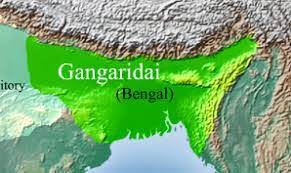
Gangariday Kingdom : The Mohenjo-Daro of the East
In 1905, on a cold and wet winter morning sitting at his office on the first floor of the Governor’s House in Calcutta, the 45-year-old Lord Curzon wrote to his counterpart St. Brodrick in London. Curzon was trying to justify his proposal of partitioning Bengal. He wrote, -“The Bengalees consider themselves a separate nation and indulge in dreams of driving away the British and putting a Bengalee Babu in the Government House as Governor General. The partition of Bengal would undermine their sense of superiority and destroy their dream and this is the reason why they are agitating against it. If now we submit to their loud protest and recall the partition, we shall never be able to curb their strength.”[1]
One begs to ask – why was this urgency for partitioning Bengal?
Authorities in Britain were unsure on the repercussion of the partition and the real benefit of it to the crown. It was then that the Bengalees for the first time joined in one voice to protest against the authorities by launching Swadeshi movement across Bengal. Worried about the declining trade and political unrest St. John Brodrick, Secretary of States for India in British Cabinet sent a cable to Curzon on 20 May 1905 stating: “instead of partitioning Bengal, Chota Nagpur and Orissa be separated from it to aid administrative purposes.”[2]
Curzon immediate reply was: “Such a step would only increase still further the unity and influence of the Bengalees and only add to the evil that we want to eradicate by the partition.”[3]
Curzon understood the strength of united Bengal, and despite all opposition, against tremendous public protest and with only oblique support from Britain, the partition of Bengal was executed on 16 October 1905 on the day of Vijayadashami.[4]
What prompted Curzon to the partition of Bengal is nobody’s guess. He was only following the 2000-year-old Greek war strategy of ‘Divide and Rule’. If we glance through history we see that the ‘divide and rule’ strategy ironically was propagated by Philip II of Macedon, the father of Alexander the Great in 350BC. It seems as if Curzon was finishing up the incomplete work of Alexandra. Curzon was in an unknown dread and an unexplained hurry to partition when everything was going on perfectly well for the East India Company. But why?
Curzon whose childhood was spent under the tyranny of his governess, a person who never sighed away from creating adversaries on his path understood the might of the Bengalees. The slightly built, docile, well-mannered, educated, and intelligent Bengalees when United is a formidable force, hence the urgency for partition and hitting at the very core of the Bengali strength.
Let’s pause here and move back in time by roughly 2000 years and what was the true nature and achievement of this Bengalees. When reading the accounts of the ethnographer Megasthenes’ [5] a contemporary of Alexandra, in his work “Indika” [6], we find that after conquering almost the whole of known world Alexander had to stop on the banks of the river Beas in Punjab. Alexandra and his war-weary army turn back seeing the might of Prasii and Gangariday kingdoms (Green colored).

Megasthenes documented, “Now this river (Ganga), which at its source is 30 stadia [7] broad, flows from north to south, and empties its waters into the ocean forming the eastern boundary of the Gangaridai (Gangariday), a nation which possesses a vast force of the largest-sized elephants. Owing to this, their country has never been conquered by any foreign king: for all other nations dread the overwhelming number and strength of these animals. [8]. Thus Alexander the Macedonian, after conquering all Asia, did not make war upon the Gangaridai, as he did on all others; for when he had arrived with all his troops at the river Ganges, he abandoned as hopeless an invasion of the Gangaridai and India when he learned that they possessed four thousand elephants well trained and equipped for war.” [9]
Pataliputra (present day Patna) was referred to as Prasii with Dhana Nada as the king. While Gangariday (made up of two words – Ganga and riday or heart) the land with the river Ganga in its heart, that is the undivided Bengal. Dhana Nanda was the king during Alexander’s conquest but both never got to meet each other, as Alexander’s army refused to go any further due to the dread of the military power of Prasii and Gangariday kingdoms. While Pataliputra and Magadha kingdoms have been taught to us over and over in our history books, but there is no mention of Gangariday anywhere. How could we afford to overlook Gangariday kingdom, is it a conspiracy, to keep the Bengalees unaware of their past glories and strength?
Now let’s take a close look at the Gangariday kingdom of antiquity. It was an area at least 500,000 square kilometers that are twice the area of United Kingdom if not more. Gangariday is the cultural identity of all Bengalees on either side of the present border. The identity was forged with the language they developed – Bangla. Gangariday people are a racial group, intermixed by the descendants of migrating cave people of central India with the Mongoloid people of Tibet and Burma of the cold climate and spoke in the proto-Prakrit dialect of eastern style. They developed their own writing system which was proto-Brahmi from which ancient Burmese (Burma), Siamese (Thailand), Javanese (Indonesia) and Mindanao (Philippines) alphabets were formed. [10]
The history of Gangariday is much older than we can imagine. Recently discovered archaeological sites like Chandraketugarh in West Bengal abounds with evidence on the fact that people have continuously settled in Bengal or Gangariday as far back as 2000 BC and is referred as the Mohenjo-Daro of the East. Sophisticated city planning and fortification, along with inscriptions on terracotta tablets, silver and copper coins points to a highly civilized group of people who inhabited the area.
Bengalees always maintained a separate identity from the rest of the country and were called ‘Bong’, from where Vanga and Banga were subsequently derived. The people of Gangariday were a race that unlike the rest of India was seafaring and established colonies in Burma in 923 BC. By 700 BC they were the ruling class in Vietnam, Chinese records confirm that the name of the king was Luck-lom and he belonged to the place Bong-long. They also affirm that Bong-longs were of Naga vamsa (lineage). The word ‘lom’ is similar to ‘la’ French meaning the ‘the’. We still carry the ‘la’ in the word ‘Bangla’.
It is estimated that around 500 BC Gangariday people ruled almost all of the Bay of Bengal including some parts of South India. Down south they were called ‘PangalaThiraiyars’ that is BangalaTira-Vanga or people from coastal Bengal which is modern day Tamluk (Tamralipta as mentioned in Mahabharata). Both the words ‘Pangala’ and ‘Bangala or Bangla’ means riverside land. Ancient Tamil records also point out that this group was Naga-worshipers. Two other groups from north-western part of Gangariday region migrated to South India, they were called Marans, and the Cheras. [11]
Cherasand Marans or the Pandya dynasty both worshipped goddess Kali Chera’s is Keralaworshipped goddess Kali as Kottavai. Around 500 BC Prince Vijay Singha from Gangariday landed with his 7 hundred men on the shores of modern day Sri Lanka, on the very day of Gautam Buddha’s death. Sinhal, was named after the king Vijay Singha, and the close genetic link of Sinhalese with Bengalees have been recently proved in some studies. The Gangariday kingdom controlled the entire spice route in the east and evidence of trade with Greece and Middle Eastern countries prove the point that they were far ahead of their time. Later on, around 300 BC Gangariday kingdom had their capital shifted from Chandraketugarh to Gopalganj district of present-day Bangladesh. Today however most people know Gopalganj as the birthplace of the Bangabondhu Sheikh Mujibur Rahman.

The entire history of India has been dated by British scholars with one single assumption that Chandragupta Maurya was referred to as Sandrocottus by Megasthenes. However, recently Archaeological Survey of India (ASI) and a group of researchers from IIT Kharagpur claim to have proof that the Sandrocottus as mentioned in Indikawas actually king Chandraketu of Gangariday kingdom. [12]
If it is proved that Sandrocottus was, in fact, king Chandraketu then the entire history and the timeline of Indian kingdoms will have to be rewritten with Gangariday becoming the center point. Gangariday kingdom may have faded in the annals of history, but all Bengali speaking people should be proud of their special place in shaping the destiny of the sub-continent and being a kingdom that was never conquered by foreign forces.

A united Bengal whether it was the British or the Greeks was something that could never be conquered unless weakened from within. After the partition of Bengal was rescinded in 1911, when millions of Bengalees rejoiced, the British did not find itself safe anymore facing the United Bengal. They immediately shifted their capital from Calcutta to Delhi, when King George V was crowned the Emperor of India. Finally, when the British left India in 1947 they made it a point to divide Bengal once and for all. Even in 1971 when Indira Gandhi helped the Muktibahini to win freedom from Pakistan capturing 90,000 Pakistani troops, she did not explore the option of annexing East Bengal through democratic means, she knew it would be too much to handle for her as well.
Amidst the injustice of divide of the motherland by foreign forces, there are millions of Bengalees on either side of the border and worldwide who wish to live together as brothers and brethren once again and rebuild the kingdom of Gangariday. The song Rabindranath Tagore composed as a protest against the partition of Bengal in 1905, has not lost its relevance in the hearts of Bengalees even today, they still sing….
B?ng?l?rpran, B?ng?l?rmon (Bengalees soul, Bengalees heart)
B?ng?l?rghareyjatabh?i bon (all the brothers and sisters in Bengalees home)
EkhaukEkhayuk (may become one, may become one)
Ekhauk hey Bhagaban (may become one, oh lord)
Reference and Notes:
[1] R. C. Majumdar, History of Bengal, Part 2 (Calcutta: G. Bharadwaj & Co., 1981). Letter dated January 17, 1904, by Lord George Curzon, Viceroy of India.
[2] Ibid.
[3] Ibid.
[4] Vijayadashami marks the day when Goddess Durga defeated the demon Mahisasura as per Indian mythology, symbolically the victory of good over evil. The day has special relevance in Bengali cultural and religious tradition.
[5] Megasthenes was the ambassador of Seleucus I Nicator, who was a military general to Alexander, deputed in India.
[6] Indika (Greek: ?νδικ?; Latin: Indica) is an account of Mauryan India by Megasthenes. The original book is now lost, but its fragments have survived in later Greek and Latin works.
[7] 1 stadion = 157.7 meters; 30 stadia = 4.73 kilometers, roughly.
[8] The actual reason behind Alexander not waging a war with India cannot be confirmed but multiple sources mention it was because of the Gangariday kingdom’s might and their 4000 elephants.
[9] Megasthenes (c. 350 BC to 290 BC). Quoted from the Epitome of Megasthenes, Indika (Diod. II. 35–42), Ancient India as Described by Megasthenes and Arrian. Translated and edited by J.W. McCrindle.
[10] Sambhu Nath Mondal, Decipherment of Indus-Brahmi Inscriptions of Chandraketugarh (Gangahrada)—The Mohenjodaro of East India (Mr. Shankar Prasad Saha, 2006).
[11] Bijaychandra Mazumdar, The History of the Bengali Language (Calcutta: University of Calcutta, 1920).
[12] Jhimli Mukherjee Pandey, “Was Sandrocottus Bengal’s Chandraketu?” Times of India, August 22, 2016. Available at: http://timesofindia.indiatimes.com/city/kolkata/Was-Sandrocottus-Bengals-Chandraketu/articleshow/53806349.cms.
 Pinaki Ganguly
Pinaki Ganguly 

Comments
Debraj S Roy
9th January, 2022Pinaki has unique way of story telling and mixing science with history. His lateral thinking has evoke many insights in past and continue to create new zeal to do new things in personal and professional sphere. A big shoutout to you Pinaki.